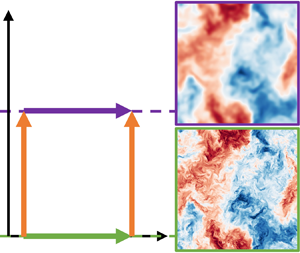Article contents
A physics-inspired alternative to spatial filtering for large-eddy simulations of turbulent flows
Published online by Cambridge University Press: 18 January 2022
Abstract

Large-eddy simulations (LES) are widely used for computing high Reynolds number turbulent flows. Spatial filtering theory for LES is not without its shortcomings, including how to define filtering for wall-bounded flows, commutation errors for non-uniform filters and extensibility to flows with additional complexity, such as multiphase flows. In this paper, the theory for LES is reimagined using a coarsening procedure that imitates nature. This physics-inspired coarsening approach is equivalent to Gaussian filtering for single-phase wall-free flows but opens up new insights for both physical understanding and modelling even in that simple case. For example, an alternative to the Germano identity is introduced and used to define a dynamic procedure without the need for a test filter. Non-uniform resolution can be represented in this framework without commutation errors, and the divergence-free condition is retained for incompressible flows. Potential extensions of the theory to more complex physics such as multiphase flows are briefly discussed.
JFM classification
- Type
- JFM Papers
- Information
- Copyright
- © The Author(s), 2022. Published by Cambridge University Press
References
REFERENCES
- 7
- Cited by





